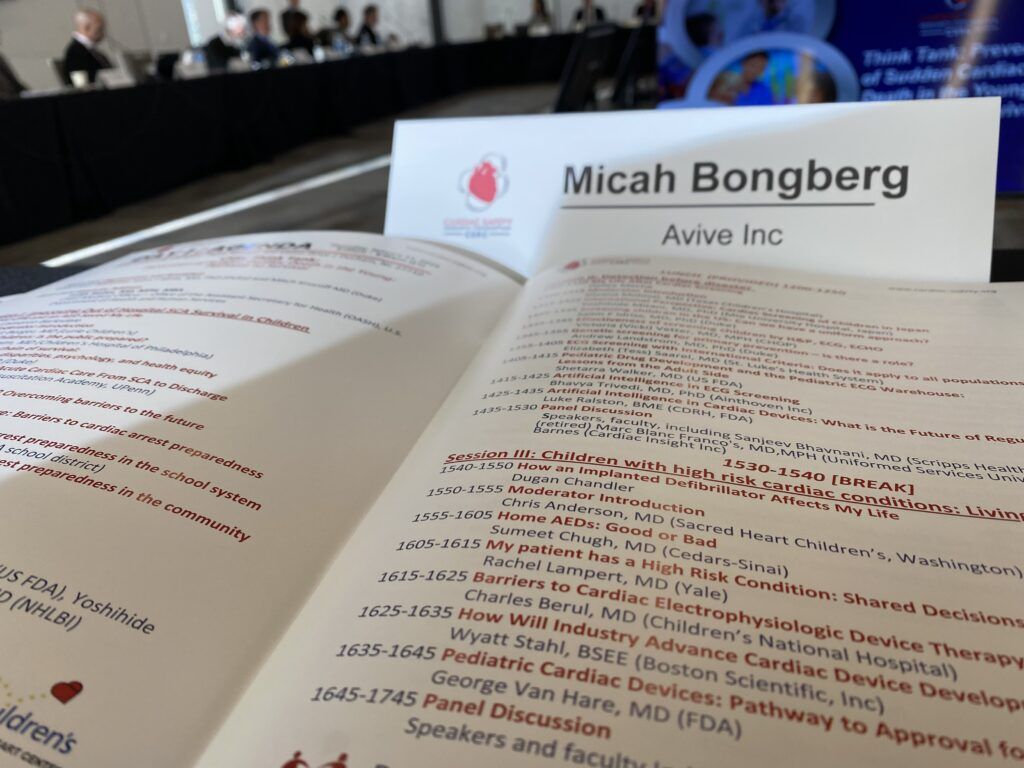Blog
Addressing Cardiac Arrest in 2024: Highlights from the CSRC Think Tank & Heart to Heart
We’re not even through the first month of the new year, and we’ve already garnered enough motivation…
5 Crucial Reasons Why You Need to Replace Your AED
As technology evolves and standards improve, there comes a time when all equipment needs to be replaced….
Employee Spotlight: Cultivating Growth with Mike Wittmann
Mike Wittmann is one of our Account Executives who has lead many company-wide sales initiatives since mid…
5 Key Features That Make an AED Easy to Use
AEDs, or automated external defibrillators, are lifesaving devices that analyze a person’s heart rhythm and deliver an…
The Evolution of CPR: Shift from Rescue Breaths to Hands-Only CPR
Created in the 1960s, CPR, or cardiopulmonary resuscitation, is a lifesaving technique that can help keep blood…
Challenging the Status Quo at 2023’s Cardiac Arrest Survival Summit
Our team had the privilege to attend the 2023 Cardiac Arrest Survival Summit (CASS) in beautiful San…
Ambulance Deserts & the Struggle For Timely Cardiac Arrest Intervention
People who live more than 25 minutes away from the nearest ambulance service live in what are…
The Shocking Truth: How Defibrillator Voltage Saves Lives During Cardiac Arrest
Out-of-hospital cardiac arrest is a serious global health problem affecting around 3.8 million people each year, with…
Employee Spotlight: Ensuring Customer Success with David Liu
David Liu is the inaugural member of Avive’s Customer Success Team, where he has helped to lead…
Can Heat Stroke Cause Cardiac Arrest?
There’s a known connection between strenuous exercise and Sudden Cardiac Arrest, but where does heat factor in? …
4 States Introduce New AED School Laws in Fall 2023
Youth spend the majority of their time at school, as do the teachers and staff who support…
Athletic Trainers & AEDs: First Line of Defense for Sudden Cardiac Arrest in Young Athletes
Introducing Mike Hopper, Head Athletic Trainer (AT) at Bishop Lynch High School in Dallas, TX and the…
Inside Avive: One of the 2024 Bay Area Best Places to Work
Few decisions in our lives are more important than where we choose to work. This is because…
Trailblazing Safety: Avive x Headlands 27k
Headlands 27k The Golden Trail World Series is coming to the United States for the first time…
Life & Community: 12th Annual Marin County Survivors’ Celebration
At Avive, we believe in the power of community, the strength of collaboration, and the lifesaving potential…
Enable Lost Mode & 4 More Benefits of AED Connectivity
In a world increasingly intertwined with technology, there are few areas where connectivity has not yet made…
In Pursuit of AED Incident Data: Nick Bogle’s Story
Nick Bogle’s Story I first have to say that my story has nothing to do with anything…
What Are the Common Causes of Cardiac Arrest in Infants and Children?
Discover the causes of cardiac arrest in children and infants and how to prevent this life-threatening condition with our detailed article.
AED IP Rating Explained: What Does IP Code Tell About AEDs
Deciphering AED features and deciding what device to purchase can be overwhelming. What are the most affordable…
Understanding First Aid Training & Its Importance
First aid training is designed to teach people the basic principles and techniques to provide immediate help…
A Life Saved with the Avive AED® Ecosystem
Case Study The following blog discusses a cardiac arrest save with an Avive Connect AED® that happened…
Understanding the Difference Between Cardiac Arrest, Heart Attack, and Stroke
Cardiac arrest, heart attack, and stroke are three terms that are often used interchangeably despite the fact…
Employee Spotlight: Spearheading Innovation with Jimy Pesin
In the realm of innovation, there are individuals who not only contribute to the advancement of technology…
February 2024: State AED Legislation & the Future of SCA Prevention
In recent years, states across the country have made efforts to improve Sudden Cardiac Arrest prevention and…
Addressing Cardiac Arrest in 2024: Highlights from the CSRC Think Tank & Heart to Heart
We’re not even through the first month of the new year, and we’ve already garnered enough motivation…
5 Crucial Reasons Why You Need to Replace Your AED
As technology evolves and standards improve, there comes a time when all equipment needs to be replaced….
Employee Spotlight: Cultivating Growth with Mike Wittmann
Mike Wittmann is one of our Account Executives who has lead many company-wide sales initiatives since mid…
5 Key Features That Make an AED Easy to Use
AEDs, or automated external defibrillators, are lifesaving devices that analyze a person’s heart rhythm and deliver an…
The Evolution of CPR: Shift from Rescue Breaths to Hands-Only CPR
Created in the 1960s, CPR, or cardiopulmonary resuscitation, is a lifesaving technique that can help keep blood…
Challenging the Status Quo at 2023’s Cardiac Arrest Survival Summit
Our team had the privilege to attend the 2023 Cardiac Arrest Survival Summit (CASS) in beautiful San…
Ambulance Deserts & the Struggle For Timely Cardiac Arrest Intervention
People who live more than 25 minutes away from the nearest ambulance service live in what are…
The Shocking Truth: How Defibrillator Voltage Saves Lives During Cardiac Arrest
Out-of-hospital cardiac arrest is a serious global health problem affecting around 3.8 million people each year, with…
Employee Spotlight: Ensuring Customer Success with David Liu
David Liu is the inaugural member of Avive’s Customer Success Team, where he has helped to lead…
Can Heat Stroke Cause Cardiac Arrest?
There’s a known connection between strenuous exercise and Sudden Cardiac Arrest, but where does heat factor in? …
4 States Introduce New AED School Laws in Fall 2023
Youth spend the majority of their time at school, as do the teachers and staff who support…
Athletic Trainers & AEDs: First Line of Defense for Sudden Cardiac Arrest in Young Athletes
Introducing Mike Hopper, Head Athletic Trainer (AT) at Bishop Lynch High School in Dallas, TX and the…
